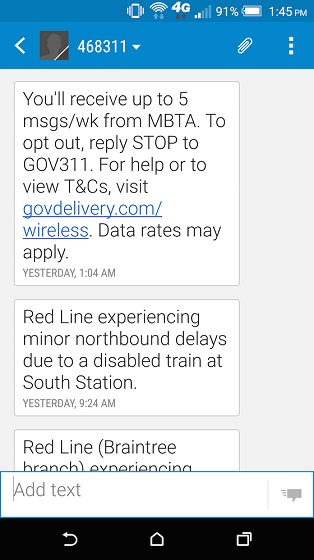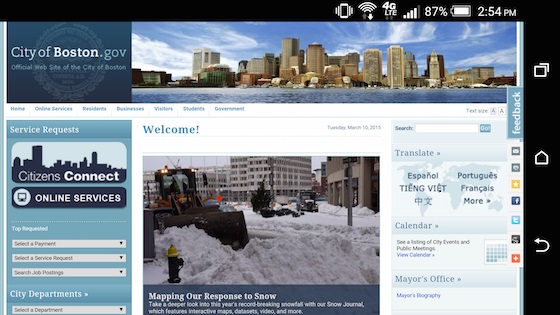E-Government
Abstract
[Provide a summary of the article here.]
What is E-Government?
The Internet has allowed people to connect with others across the world. People can access up-to-date information with the click of a button; information is more readily available and easy to access. The United States government is taking advantage of these technological advances through Electronic Government, or E-Gov. Its purpose is to improve government services and operations through digital media and the Internet. Digital media includes but is not limited to websites, mobile applications, and social media outreach. It was created to enhance government operations and was not intended to replace traditional government. E-gov is meant to improve government affairs, connect citizens, and build relationships with other institutions.
The Internet and digital media is embedded into people’s daily lives. The average American adult spends 11 hours per day with electronic media (Petronzio). Consumers use computers, smartphones, and the Internet without realizing the engineers behind the technology. In the next section, a brief history of the first computer and the Internet will be discussed.
The First Computer and the Internet
The world’s first computer was created in 1946 and it was called the Electronic Numerical Integrator and Computer (ENIAC). It started as a research project for the American military. The computer performed 5,000 instructions per second, weighed 30 tons, took up 1,000 square feet of space, and cost $6 million, after taking into account inflation (Timeline of Computer History). Basically, it was a giant, slow, and expensive calculator. Engineers worked hard to make cheaper, faster, and more portable computers. Computers today are 16 million times faster, 13,000 times lighter, and 5,000 times cheaper. Computer engineers are responsible for designing computer components with these specifications. These advances made technology affordable to the public and allowed more people to gain access to it.
The Internet, like ENIAC, started off as a research project and only scientists had access to it. It was created in 1969 and did not become available to the public until late 1990’s (Cerf). The Internet allows the exchange of information between devices connected to a network. Engineers are constantly finding ways to make the Internet faster, more reliable, and more secure. Without engineers, computers and the Internet would not exist. Without the Internet, programs like E-Gov would not have a platform to host their information and services.
E-Gov Services
The two main services provided by E-Gov are online information and electronic self-service. The implementation of E-Gov has led to the creation of government websites. In 2008, it was reported that 89% of government agencies have a website (West). These websites give people instant access to information through the Internet. There are more ways of obtaining information; people no longer have to call or physically go to an office during normal business hours to get the answer they are looking for.
Figure 1
Caption Text. Source: Author.
Websites provide another source for information. Before the Internet, people obtained information through government offices, phone calls, or booklets. With websites, users are able to see the information as soon as it is published. Government websites can be distinguished by their “.gov” domain name. These websites provide a wide range of information and varies from department to department. Since the government covers a diverse group of agencies, sites can range from health information (National Institute of Health) to flight regulations (FAA.gov). Each website lists general information about the department, the head of the department, contact information, important notices, job opportunities, and more. For example, a few resources on the City of Boston’s website include current events, job opportunities, social media handles, and ways to obtain online services.
E-serve, or electronic service, allows users to serve themselves and do not require interaction between the user and employee. Once the user submits their information, an employee can review the application to ensure all fields were entered correctly. This feature is similar to self-checkouts in grocery or drugstores. People continue to have the option of obtaining services through a phone calls or physical government office setting. With the help of engineers who build these websites, more options are available for people to choose from. Some examples of these services include online tax filing, license renewal, vehicle registration, email subscriptions, scheduled notifications, and paying for traffic tickets.
Figure 2
Caption Text. Source: Author.
Services through E-serve are more consistent and accurate because all users will be accessing services from the same website. In the early 1990’s, the Department of Revenue (DOR) was asked to lower the number of employees and maintain service quality. As a result, an online service was established to allow people to file their taxes electronically (The Benefits of E-Government). The number of electronic tax files quadrupled in a five-year period between 1995 and 2000 from 222,000 to 817,000 electronic tax returns. E-Gov comes with a tradeoff of reducing employees, while providing convenience and streamlined service to users.
Under Massachusetts’ Public Safety Agencies is the Massachusetts Emergency Management Agency (MEMA). Their mission is to ensure that the state is prepared to withstand, respond, and recover from all types of emergencies and natural disasters. The agency displays alert notifications for declaration of state of emergencies, natural disasters, homeland security threats, hazardous material spills, extreme weather or state government closings, and other life-threatening situations (MEMA Mission). In addition to the website, the agency also has an application for smartphones that delivers push notifications when an alert is released.
Figure 3
Caption Text. Source: Author.
In 2014, it was reported that the number of broadband (Internet) subscribers surpassed the number of cable subscribers (Wohlsen). This means that the government can no longer rely on cable or television to transmit important information to its citizens. They must reach out to people through the Internet, such as websites, phone applications, and social media. Imagine how long it would take for alerts to reach people through paper means or phone calls. Engineers developed a more efficient way to deliver alerts and notifications with website messages and text messages. Amber Alerts send text messages to mobile devices around the area of a missing child in real time. The first 48 hours of a child’s missing is the most critical time and with the help of this technology, more people are involved to look for the child. Amber Alerts use technology developed by electrical and computer engineers to detect whether a device is in the radius of the missing child and notifies the cell phone owner to keep an eye out for certain people or vehicles. In January 2013, all Wireless Emergency Alert-enabled phones will receive messages based on location of the device. Engineers are able to track the location of mobile devices and selectively send messages to devices in a certain area.
Fiscal Benefits
E-Gov was designed to increase fiscal savings, convenience, and provide more accurate services. At the start of the implementation of E-Gov, Massachusetts’ Office of Administration and Finance predicted that E-Gov programs would save $250 million dollars within a five-year period (The Benefits of E-Government). This prediction is solely based on benefits for the Government and does not take into account social benefits or savings for the public. In another example, the Department of Education moved to logging work hours electronically and was able to save half a million dollars in 2013 from eliminating the timekeeper function. This is one of the many examples of fiscal savings from product of E-Gov.
Cyber Security
Target’s security breach brought to light the importance of cyber security and keeping people’s data safe. Thieves stole 40 million credit and debit cards from Target, along with 70 million records with customers’ name, address, email address, and phone number (Krebs). Similar to Target, government agencies store certain user information for E-serve transactions. If big companies like Target are vulnerable to hackers, government agencies are no exception. Engineers are working hard to keep people’s data safe by creating more complex encryption methods.
Cyber security is an initiative targeted to protect computers, networks, and data from unauthorized access. When someone enters their personal information to a website, they expect the site to keep their information safe. Malicious attacks can lead to identity theft and information leakage. More people are relying on modern technology and as a result, people are more vulnerable to cyber attacks. Cyber security is integral in maintaining security in sensitive information. Computer and electrical engineers are responsible for creating secure networks to prevent or intervene cyber attacks. Sensitive information is encrypted and requires an encrypted key to decipher the data (Encryption). Encrypted information has no meaning to someone who does not have the key to translate the material. The government is taking steps to invest in cyber security and creating intrusion detection tools to monitor traffic in .gov websites (Secure Cyber Networks). These tools will alert administrators of any malicious activities and allow them to address the problem as soon as it occurs (Secure Cyber Networks). There is continuous research on Internet security to better understand the areas of vulnerability.
Conclusion
E-Gov aims to make government processes more efficient and increase digital communication between citizens and businesses. From the government side, the digitization of information and tasks led to fiscal savings. From the citizens and businesses side, information is more accessible. While E-Gov has its benefits, it must maintain security measures to keep government and individuals’ information safe. Cyber security is an issue that engineers are working to combat. Think of engineers as cyber security guards who use their knowledge and skills to keep sensitive data safe. Without their efforts, your personal information will be vulnerable to identity fraud. Engineers made E-Gov possible and are continuing to protect it from malicious attacks.
Bibliography
- Petronzio, M. (2014, March 5). U.S. Adults Spend 11 Hours Per Day With Digital Media. Retrieved from http://mashable.com/2014/03/05/american-digital-media-hours/
- Computer History Museum. (n.d.).Timeline of Computer History : Computers Entries. Retrieved from http://www.computerhistory.org/timeline/?category=cmptr
- Cerf, V. (n.d.). Brief History of the Internet. Retrieved from http://www.internetsociety.org/internet/what-internet/history-internet/brief-history-internet
- West, D. (2008). State and Federal Electronic Government in the United States. Governance Studies in Brookings. Retrieved from http://www.brookings.edu/research/reports/2008/08/26-egovernment-west
- Massachusetts Emergency Management Agency (MEMA). (n.d.). MEMA Mission. Retrieved from http://www.mass.gov/eopss/agencies/mema/mema-mission.html
- Wohlsen, M. (2014, August 14). The Internet Is Officially More Popular Than Cable in the U.S. Retrieved from http://www.wired.com/2014/08/the-internet-is-now-officially-more-popular-than-cable-in-the-u-s/
- The Benefits of E-Government. (n.d.). Retrieved from http://www.mass.gov/anf/research-and-tech/it-planning-and-collab/strat-planning/prev-plans/e-gov-strat-plan/section-2-the-benefits-of-e-government.html
- Krebs, B. (2014, May 4). The Target Breach, By the Numbers. Retrieved from http://krebsonsecurity.com/2014/05/the-target-breach-by-the-numbers/
- Encryption. (n.d.). Retrieved from https://source.android.com/devices/tech/security/encryption/
- Secure Cyber Networks. (2013, November 1). Retrieved from https://www.dhs.gov/secure-cyber-networks
Suggested Reading
- List at least one authoritative resource for more general background – a good, freely available government site is recommended, also the Cerf article, which is now a classic.
See also (Links to other SHP articles):
- Bullet List (list by author name and preliminary topic other SHP articles that seem strongly connected to your topic; maximum of five; you may also list articles from previous years as well as projects from the annual project lists)



